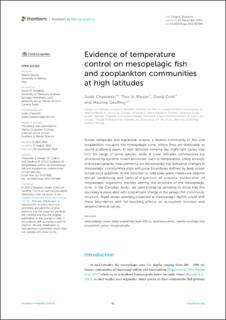| dc.contributor.author | Chawarski, Julek | |
| dc.contributor.author | Klevjer, Thor A. | |
| dc.contributor.author | Coté, David | |
| dc.contributor.author | Geoffroy, Maxime | |
| dc.date.accessioned | 2022-10-25T12:04:24Z | |
| dc.date.available | 2022-10-25T12:04:24Z | |
| dc.date.created | 2022-10-20T10:11:46Z | |
| dc.date.issued | 2022 | |
| dc.identifier.citation | Frontiers in Marine Science. 2022, 9 . | en_US |
| dc.identifier.issn | 2296-7745 | |
| dc.identifier.uri | https://hdl.handle.net/11250/3028197 | |
| dc.description.abstract | Across temperate and equatorial oceans, a diverse community of fish and zooplankton occupies the mesopelagic zone, where they are detectable as sound-scattering layers. At high latitudes, extreme day-night light cycles may limit the range of some species, while at lower latitudes communities are structured by dynamic ocean processes, such as temperature. Using acoustic and oceanographic measurements, we demonstrate that latitudinal changes in mesopelagic communities align with polar boundaries defined by deep ocean temperature gradients. At the transition to cold polar water masses we observe abrupt weakening and vertical dispersion of acoustic backscatter of mesopelagic organisms, thereby altering the structure of the mesopelagic zone. In the Canadian Arctic, we used biological sampling to show that this boundary is associated with a significant change in the pelagic fish community structure. Rapid ocean warming projected at mesopelagic depths could shift these boundaries with far-reaching effects on ecosystem function and biogeochemical cycles. | en_US |
| dc.language.iso | eng | en_US |
| dc.title | Evidence of temperature control on mesopelagic fish and zooplankton communities at high latitudes | en_US |
| dc.title.alternative | Evidence of temperature control on mesopelagic fish and zooplankton communities at high latitudes | en_US |
| dc.type | Peer reviewed | en_US |
| dc.type | Journal article | en_US |
| dc.description.version | publishedVersion | en_US |
| dc.source.pagenumber | 11 | en_US |
| dc.source.volume | 9 | en_US |
| dc.source.journal | Frontiers in Marine Science | en_US |
| dc.identifier.doi | 10.3389/fmars.2022.917985 | |
| dc.identifier.cristin | 2063107 | |
| dc.relation.project | Norges forskningsråd: 267416 | en_US |
| cristin.ispublished | true | |
| cristin.fulltext | original | |
| cristin.qualitycode | 1 | |
